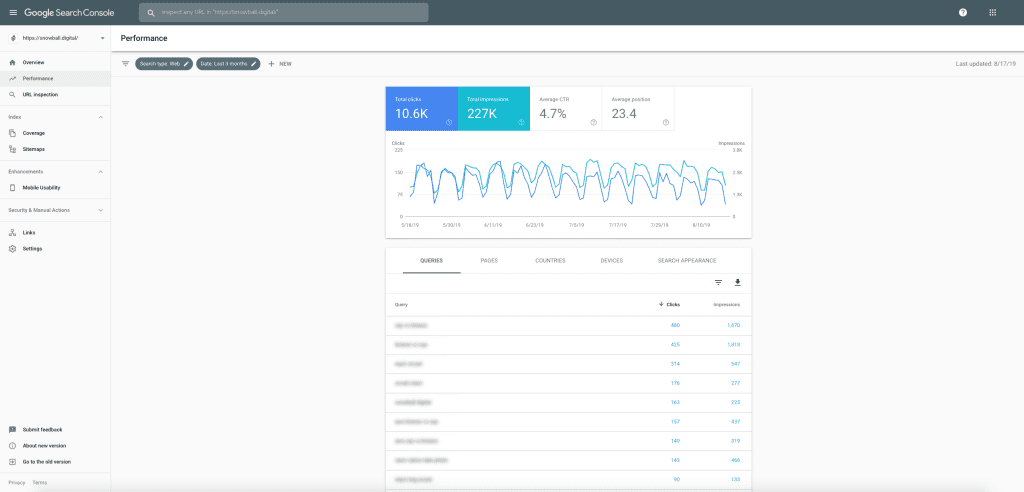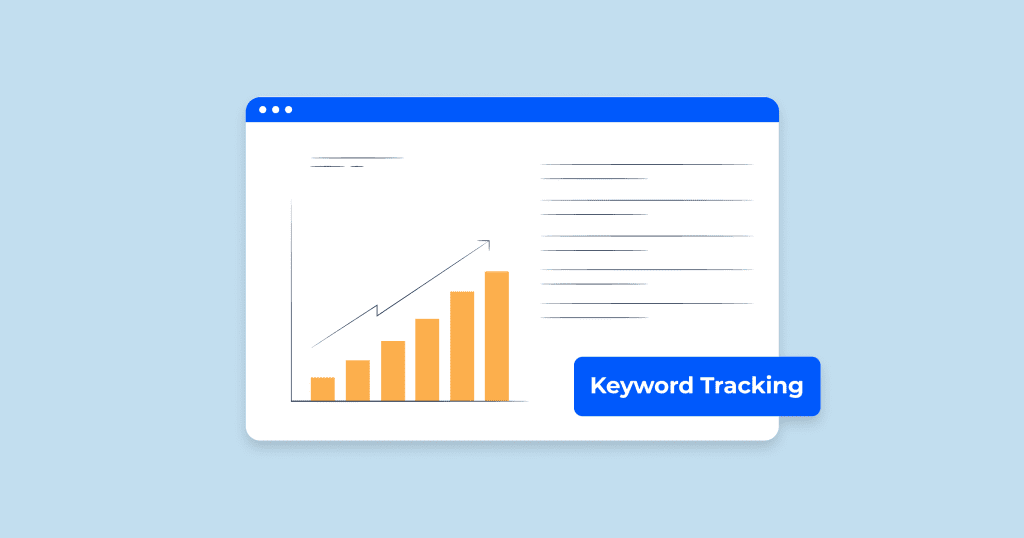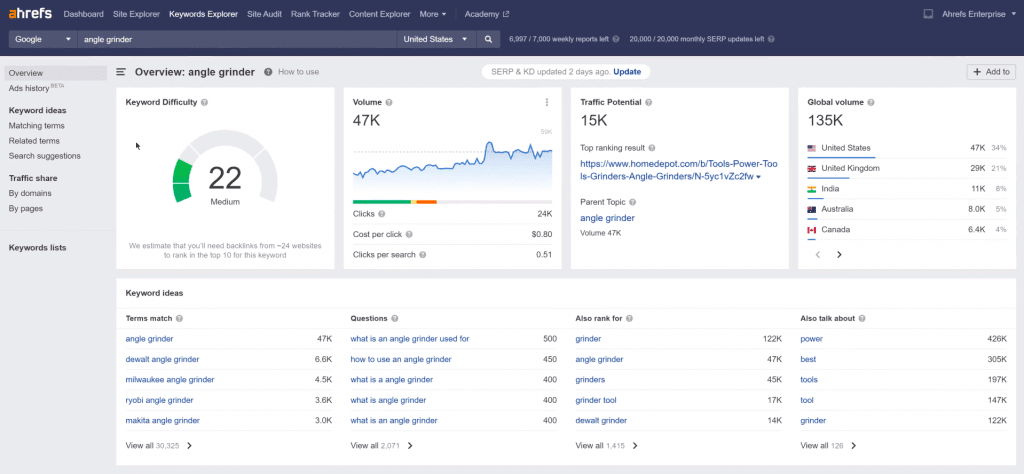Key Takeaways
- Strategic Setup for Success: Learn the art of effective keyword tracking setup, aligning your content with user intent, and adapting to ever-changing search engine algorithms.
- Troubleshoot with Precision: Equip yourself with insights to troubleshoot common SEO issues, address fluctuations in keyword rankings, adapt to algorithm updates, and stay ahead of industry trends.
- Future-Ready SEO: Embrace emerging technologies, from AI-driven content creation to optimizing for visual and voice search, ensuring your SEO strategy remains innovative and future-ready.
In the ever-evolving landscape of digital marketing, staying ahead in the search engine optimization (SEO) game is paramount for online success.
As businesses strive to enhance their online presence, the significance of strategic keyword usage becomes increasingly apparent.
One crucial element that often separates SEO novices from seasoned professionals is the art and science of keyword tracking.
If you’ve found yourself wondering about the intricacies of keyword tracking and how to wield it effectively in your SEO arsenal, you’re in the right place.
This comprehensive guide will unravel the mysteries surrounding keyword tracking, offering not only a thorough understanding of its essence but also a step-by-step roadmap on how to set it up for optimal SEO performance.

Why Keywords Matter in the SEO Landscape
Before delving into the nuances of keyword tracking, let’s first grasp the fundamental role that keywords play in the SEO ecosystem. Keywords serve as the digital compass guiding search engines to relevant content.
Users express their queries through keywords, and search engines, in turn, scour the vast digital landscape to deliver the most pertinent results.
Effective keyword usage is akin to planting seeds in the fertile soil of the internet — the right seeds yield bountiful crops.
In the digital realm, these “crops” translate into higher search engine rankings, increased visibility, and ultimately, a surge in organic website traffic.
However, the challenge lies not just in selecting the right keywords but in monitoring and adapting to their performance over time.
Cracking the Keyword Tracking Code
Enter keyword tracking — a dynamic process that involves monitoring the performance of chosen keywords and phrases.
It’s the compass recalibration in the vast sea of cyberspace, ensuring that your content aligns with what your target audience is actively searching for.
Imagine embarking on a cross-country road trip without a map or GPS.
Keyword tracking is your digital navigation system, providing real-time insights into the changing landscapes of search engine algorithms and user behaviour.
It’s not merely about knowing which keywords to use initially; it’s about understanding how those keywords fare in the dynamic and ever-shifting currents of the online realm.
Unpacking the Keyword Tracking Toolkit
Setting up an effective keyword-tracking system involves more than just a basic understanding of popular search terms.
It requires the right tools and methodologies to navigate the intricate SEO terrain successfully.
From identifying high-value keywords to choosing the right tracking tools, this guide will equip you with the knowledge and skills needed to establish a robust foundation for your SEO strategy.
As we embark on this exploration into the realm of keyword tracking, brace yourself for a journey that transcends the basics.
We’ll not only demystify the technical aspects but also unveil the strategic nuances that can elevate your website’s visibility and relevance in the digital sphere.
So, buckle up, because, by the end of this journey, you’ll not only comprehend the intricacies of keyword tracking but also be empowered to implement a setup that propels your website to the zenith of search engine success.
But, before we venture further, we like to share who we are and what we do.
About AppLabx
From developing a solid marketing plan to creating compelling content, optimizing for search engines, leveraging social media, and utilizing paid advertising, AppLabx offers a comprehensive suite of digital marketing services designed to drive growth and profitability for your business.
AppLabx is well known for helping companies and startups use SEO to drive web traffic to their websites and web apps.
At AppLabx, we understand that no two businesses are alike. That’s why we take a personalized approach to every project, working closely with our clients to understand their unique needs and goals, and developing customized strategies to help them achieve success.
If you need a digital consultation, then send in an inquiry here.
What is Keyword Tracking and How to Set Up for SEO?
- Understanding Keyword Tracking
- Benefits of Keyword Tracking
- Setting Up Keyword Tracking for SEO
- Troubleshooting Common Issues
1. Understanding Keyword Tracking

Definition of Keyword Tracking
In the expansive realm of search engine optimization (SEO), keyword tracking stands as a beacon guiding digital marketers through the intricate maze of online visibility.
At its core, keyword tracking involves the systematic monitoring and analysis of specific keywords or phrases to evaluate their performance in search engine results.
The Essence of Keyword Tracking
Keyword tracking is not merely a passive observation but an active strategy that empowers marketers to adapt to the ever-changing landscape of search engine algorithms.
By understanding how chosen keywords resonate with search engines and users alike, businesses can refine their content and online strategies, ultimately enhancing their digital footprint.
The Dynamics of Keyword Evolution
Keywords are not static entities; their efficacy fluctuates based on numerous factors, including changes in user behaviour, industry trends, and search engine algorithms.
For instance, a keyword that gained prominence last year might experience a decline in relevance due to evolving user preferences or a shift in search engine ranking criteria.
Importance of Monitoring Keyword Performance
To appreciate the significance of keyword tracking, it’s crucial to recognize its impact on the broader spectrum of SEO success.
Here, we dissect the key reasons why monitoring keyword performance is indispensable for digital marketers.
Enhanced User Engagement and Experience
Keyword tracking enables businesses to align their content with the language their target audience uses during online searches.
By incorporating these insights into website content, businesses can enhance user experience, resulting in longer on-site durations and decreased bounce rates.
According to a study by Backlinko, the top 3 Google search results get 54.4% of all clicks. This highlights the critical role of targeted keywords in capturing user attention and driving engagement.
Improved Search Engine Visibility
Keyword tracking is the compass that guides businesses toward optimal search engine visibility.
By identifying high-performing keywords and adapting content accordingly, websites can ascend the ranks on SERPs, ensuring they are readily discoverable by their target audience.
A study indicates that the first organic result on Google’s SERP scores an average click-through rate of 28.5%. This underscores the importance of securing top positions through effective keyword optimization.
Strategic Content Tailoring
Understanding how keywords perform over time empowers businesses to tailor their content strategies strategically.
By identifying keywords with consistently high performance, marketers can create content that resonates with their audience, building authority and credibility in their niche.
HubSpot reports that companies that published 16+ blog posts per month got almost 3.5X more inbound traffic than companies that published between 0-4 monthly posts.
This emphasizes the correlation between consistent, keyword-optimized content creation and increased website traffic.
Connection Between Keyword Tracking and SEO Success
The synergy between keyword tracking and overall SEO success is undeniable.
In this section, we explore how effective keyword tracking lays the foundation for a robust SEO strategy.
Aligned Content Strategy
Keyword tracking ensures that the content created aligns seamlessly with the evolving language and preferences of the target audience.
This alignment is pivotal for search engines to recognize the relevance of a website’s content and, consequently, improve its ranking.
Targeted Traffic Acquisition
By consistently tracking keywords, businesses can attract traffic that is not just voluminous but also highly targeted.
This targeted approach is instrumental in converting visitors into customers, as the content aligns closely with their specific needs and queries.
Competitor Analysis for Strategic Advantage
Keyword tracking is not just about monitoring one’s performance but also gaining insights into the strategies employed by competitors.
By analyzing competitor keyword tactics, businesses can identify gaps, capitalize on untapped opportunities, and refine their own SEO strategy.
In essence, the symbiotic relationship between keyword tracking and SEO success is a dynamic force that propels businesses toward digital excellence.
By comprehensively understanding how chosen keywords perform and adapting strategies accordingly, businesses can navigate the competitive digital landscape with finesse and achieve sustained online success.
2. Benefits of Keyword Tracking

Enhanced Visibility and Ranking on Search Engines
Keyword tracking plays a pivotal role in elevating a website’s visibility on search engines, subsequently influencing its ranking.
Here, we delve into the tangible benefits of keyword tracking in this regard.
Targeted Keyword Optimization
Keyword tracking enables businesses to identify high-performing keywords and strategically integrate them into their content.
By tailoring content to align with these keywords, websites stand a better chance of ranking higher on search engine results pages (SERPs).
This underscores the importance of targeted keyword optimization for improved rankings.
Increased Click-Through Rates (CTR)
Effective keyword tracking contributes to higher CTRs as it aligns content with user intent.
Users are more likely to click on search results that precisely match their queries, leading to increased traffic for websites employing a robust keyword tracking strategy.
The #1 result in Google’s organic search results has an average CTR of 31.7%, emphasizing the correlation between top-ranking positions and increased click-through rates.
Authority Building Through Top Rankings
Consistent tracking of keywords allows businesses to secure top positions on SERPs.
High rankings not only drive traffic but also contribute to the perception of authority and credibility in the eyes of users.
A study that 75% of users never scroll past the first page of search results.
This highlights the critical importance of securing top rankings for increased visibility and authority.
Enhanced Website Traffic and User Engagement
Keyword tracking is a catalyst for driving organic traffic and fostering meaningful user engagement.
Let’s explore how this process unfolds.
Organic Traffic Surge
By optimizing content for relevant keywords identified through tracking, businesses can attract organic traffic.
This traffic, stemming from users actively searching for specific information, is inherently more valuable and likely to convert.
Websites with active blogs have 434% more indexed pages and 97% more inbound links than those without, showcasing the impact of consistent content creation and keyword optimization on organic traffic.
Reduced Bounce Rates
Keyword tracking aids in creating content that precisely matches user intent, reducing bounce rates.
When users find content that directly addresses their queries, they are more likely to explore further, resulting in prolonged on-site durations.
Enhanced User Experience
Keyword tracking facilitates the creation of content that speaks the language of the target audience.
This alignment not only attracts users but also enhances their overall experience by providing relevant and valuable information.
Competitor Analysis for Strategic Advantage
Keyword tracking extends beyond individual performance, offering insights into competitor strategies.
This competitive intelligence provides a strategic advantage in the dynamic landscape of online visibility.
Identifying Competitor Strengths and Weaknesses
Through keyword tracking, businesses can assess which keywords competitors are targeting successfully and identify potential gaps or weaknesses in their own strategies.
Capitalizing on Untapped Opportunities
By analyzing competitor keyword data, businesses can uncover untapped opportunities within their industry.
This proactive approach allows for the strategic implementation of keywords that competitors may have overlooked.
Refining Content and SEO Strategy
Competitor keyword analysis provides a benchmark for performance.
By understanding what works for competitors, businesses can refine their own content and SEO strategies, ensuring they remain competitive in their niche.
3. Setting Up Keyword Tracking for SEO
Researching and Selecting Relevant Keywords
Setting up keyword tracking for SEO begins with thorough research and selection of pertinent keywords.
This initial phase lays the foundation for a robust tracking strategy.
Identifying Target Keywords
- Keyword Research Tools: Leverage powerful tools like Google Keyword Planner, Semrush, or Ahrefs to identify high-volume and relevant keywords. These tools provide insights into search volumes, competition, and potential traffic.
- Long-Tail Keywords: Incorporate long-tail keywords for specificity. While they may have lower search volumes individually, they often collectively contribute significantly to overall organic traffic.
Example: Instead of targeting “digital marketing,” a long-tail alternative like “effective digital marketing strategies for startups” caters to a more specific audience.

Utilizing Meta Tags and Headers Effectively
- Title Tags: Integrate target keywords naturally into title tags. This is a crucial on-page SEO element that informs search engines about the main topic of a page.
Example: For a blog about digital marketing strategies, a title tag could be “Digital Marketing Success: Implementing Effective Strategies for Business Growth.”
Titles between 15-40 characters earned a much higher click-through rate than longer or shorter titles.

- Header Tags (H1, H2, H3): Structure content with headers that include relevant keywords. Search engines use these tags to understand the hierarchy and importance of content.
Example: Within a blog, the H1 could be “The Ultimate Guide to Digital Marketing Strategies,” followed by H2s for specific tactics.

Choosing the Right Tools for Keyword Tracking
Selecting the appropriate tools for keyword tracking is paramount.
Various platforms offer diverse features, allowing businesses to tailor their strategy based on individual needs.
Overview of Popular Keyword Tracking Tools
- Google Analytics: A comprehensive tool providing insights into website performance, user behaviour, and keyword data. It allows tracking the effectiveness of chosen keywords over time.
Google Analytics is used by 87.2% of the top 10,000 websites as of July 2023, showcasing its widespread adoption as an analytics solution. - Semrush: Known for its versatility, Semrush offers keyword tracking, competitor analysis, and backlink monitoring, providing a holistic view of SEO performance.
Example: Semrush can reveal which keywords competitors are ranking for, aiding in the identification of strategic opportunities.

Factors to Consider When Selecting a Tool
- Accuracy of Data: Choose a tool with accurate and up-to-date data. Outdated information can lead to misguided decisions.
The more referring domains you have, the more traffic you get, emphasizing the importance of accurate backlink data. - User-Friendly Interface: Opt for tools with intuitive interfaces to streamline the tracking process. A user-friendly platform enhances efficiency and reduces the learning curve.
Example: Ahrefs provides a user-friendly interface, allowing users to navigate seamlessly through various features, including keyword tracking.

Implementing Keyword Tracking on Your Website
Once the foundational research is complete and tracking tools are selected, it’s time to implement keyword-tracking strategies on the website itself.
On-Page Optimization for Targeted Keywords
- Content Creation: Develop high-quality, relevant content incorporating target keywords naturally. This not only attracts search engine attention but also engages site visitors.
- Image Optimization: Include keywords in alt text and file names of images to enhance their discoverability by search engines.
If a website focuses on digital marketing, an image file could be named “digital-marketing-strategies.jpg.”
Utilizing Meta Tags and Headers Effectively
- Meta Descriptions: Craft compelling meta descriptions that include relevant keywords. Although not a direct ranking factor, meta descriptions influence click-through rates.
Example: Unlock the secrets of successful digital marketing strategies. Learn proven tactics to boost your online presence and drive business growth. - Header Tags (H1, H2, H3): Continue using header tags effectively in content to reinforce keyword relevance and improve overall readability.
Example: H2s within a blog post could be “Digital Marketing Trends in 2022” and “Implementing SEO Strategies for Success.”
4. Troubleshooting Common Issues

Addressing Fluctuations in Keyword Rankings
Keyword rankings are dynamic and can experience fluctuations over time.
Understanding and addressing these variations is crucial for maintaining a stable SEO strategy.
Seasonal Trends and Adjustments
- Identifying Seasonal Patterns: Recognize that some industries experience seasonal fluctuations in search behaviour. For instance, searches for “beach vacations” may peak in summer.
Google Trends is a valuable tool for identifying seasonal search patterns. It allows users to explore the popularity of search terms over time. - Adapting Content Strategies: Adjust content strategies to align with seasonal trends. For example, a gardening website may emphasize spring-related keywords during that season.
Example: A gardening blog could publish content on “Spring Planting Tips” when approaching the planting season.

Algorithm Updates and Their Impact
- Monitoring Algorithm Changes: Stay vigilant about search engine algorithm updates, as they can significantly impact keyword rankings.
- Analyzing Performance Shifts: Following an algorithm update, analyze changes in keyword rankings and website traffic. Adjust strategies accordingly to align with the updated ranking criteria.
Example: The “Medic” update placed a greater emphasis on the experience, expertise, authoritativeness, and trustworthiness (E-E-A-T) of content. Websites in the health and wellness niche had to adjust content to meet these criteria.

Adjusting Strategies Based on Changing Industry Trends
The digital landscape evolves, and businesses need to stay ahead of emerging trends to maintain SEO success.
Integrating Voice Search Optimization
- Recognizing the Rise of Voice Search: With the increasing prevalence of voice-activated devices, optimize content for voice search queries.
- Natural Language and Conversational Tone: Tailor content to match natural language queries. Voice searches often mimic conversational language.
Example: Instead of optimizing for “best pizza New York,” consider optimizing for “Where can I find the best pizza in New York?”
Evolving Search Engine Algorithms and Their Impact
- Mobile-First Indexing: Given the prevalence of mobile searches, prioritize mobile optimization. Google’s mobile-first indexing prioritizes the mobile version of a site for indexing and ranking.
In the first quarter of 2023, mobile devices (excluding tablets) generated 58.33 per cent of global website traffic, emphasizing the significance of mobile optimization. - Structured Data Markup: Implement structured data markup to provide search engines with context about the content on your pages.
Example: Adding schema markup for a recipe can provide search engines with details like cooking time, ingredients, and ratings, enhancing the visibility of the content.

Emerging Technologies Shaping the Future of SEO
The landscape of SEO continues to evolve with emerging technologies.
Staying ahead of these trends is crucial for long-term success.
Artificial Intelligence (AI) and Machine Learning
- AI-Driven Content Creation: Explore AI tools for content creation. These tools analyze user behaviour to generate content that aligns with audience preferences.
By 2025, big companies will be using generative AI tools like Stable Diffusion to produce an estimated 30% of marketing content, highlighting the growing role of AI in content creation. - AI-Enhanced Personalization: Implement AI-driven personalization to tailor content based on individual user preferences and behaviour.
Example: Netflix utilizes AI algorithms to recommend content based on user viewing history and preferences.

Visual and Voice Search Optimization
- Visual Search Integration: Optimize for visual search by incorporating descriptive image alt text and leveraging image recognition technology.
- Voice Search and Local SEO: With the rise of voice search, focus on local SEO strategies to cater to location-based voice queries.
Example: “Find the nearest coffee shop” is a common voice search query where local SEO becomes crucial for visibility.

Conclusion
In the intricate realm of digital marketing, where the algorithms of search engines constantly evolve and user behaviour undergoes continual shifts, mastering the art of keyword tracking is the linchpin to a successful SEO strategy.
Through the extensive exploration of “What is Keyword Tracking and How to Set Up for SEO?”, this comprehensive guide has shed light on the nuanced intricacies that underpin the world of keywords and their pivotal role in shaping online visibility.
Navigating the Dynamic Landscape of Keyword Tracking
Keyword tracking is not a static endeavour; rather, it’s an ongoing, dynamic process that demands adaptability and keen insights.
The journey begins with understanding the essence of keyword tracking – a proactive strategy that goes beyond mere observation to actively shaping content and online strategies based on real-time data.
As keywords evolve with changing user preferences, industry trends, and search engine algorithms, businesses must embrace the fluidity of the digital landscape.
The importance of recognizing and addressing fluctuations in keyword rankings, whether influenced by seasonal trends or algorithmic updates, cannot be overstated.
Businesses that adeptly navigate these fluctuations gain a competitive advantage by staying attuned to the pulse of their audience and search engines alike.
The Synergy of Keyword Tracking and SEO Success
The symbiotic relationship between keyword tracking and overall SEO success is a recurring theme throughout this guide.
Enhanced user engagement, improved search engine visibility, and strategic content tailoring emerge as the tangible benefits of meticulous keyword tracking.
By monitoring performance, businesses not only align their content with user intent but also strategically position themselves for top rankings on search engine results pages (SERPs).
From Research to Implementation: A Holistic Approach
The guide navigates through the intricacies of setting up keyword tracking for SEO, emphasizing the need for meticulous research and selection of relevant keywords.
Tools like Google Analytics, Semrush, and Ahrefs emerge as indispensable companions on this journey, offering insights, analytics, and competitive intelligence that propel businesses toward digital excellence.
The integration of selected keywords into meta tags, headers, and on-page content is not a mere checklist but a strategic endeavor to enhance the discoverability and relevance of content.
By understanding the impact of meta descriptions, header tags, and image optimization on user experience and search engine rankings, businesses can fine-tune their online presence for optimal performance.
Troubleshooting Common Issues: A Proactive Approach
As the digital landscape evolves, businesses must be equipped to troubleshoot common issues that may arise.
From addressing fluctuations in keyword rankings and adapting to algorithm updates to staying ahead of emerging industry trends, this guide provides a holistic approach to maintaining SEO effectiveness.
The exploration of emerging technologies shaping the future of SEO offers a forward-looking perspective.
From the integration of artificial intelligence (AI) and machine learning for content creation to the optimization of visual and voice search, businesses are encouraged not only to adapt to current trends but to anticipate and embrace future innovations.
Mastering the Art and Science of SEO
In the grand tapestry of digital marketing, where visibility is the currency of success, keyword tracking emerges as both an art and a science. It demands creativity in content creation, strategic thinking in keyword selection, and a scientific approach to data analysis.
This guide serves as a compass, guiding businesses through the vast sea of keywords and toward the beacon of SEO success.
As businesses embark on their SEO journey, armed with the knowledge of what keyword tracking entails and how to set up a robust strategy, they position themselves not just as passive observers in the digital landscape but as active participants shaping their destiny.
The world of SEO is dynamic, and success belongs to those who master the art of keyword tracking, adapting to change, and staying ahead of the curve.
In this ever-evolving digital ecosystem, the journey doesn’t end—it transforms into a perpetual quest for excellence, visibility, and sustained success.
If you are looking for a top-class digital marketer, then book a free consultation slot here.
If you find this article useful, why not share it with your friends and business partners, and also leave a nice comment below?
We, at the AppLabx Research Team, strive to bring the latest and most meaningful data, guides, and statistics to your doorstep.
To get access to top-quality guides, click over to the AppLabx Blog.
People also ask
What is keyword tracking in SEO?
Keyword tracking in SEO involves monitoring and analyzing the performance of specific keywords or phrases to assess their impact on search engine rankings. It’s a strategic process where businesses track how chosen keywords resonate with users and search engines, optimizing content for improved online visibility and organic traffic.
What is a word tracker in SEO?
In SEO, a word tracker refers to a tool or software that helps identify and analyze relevant keywords for a website. It aids in understanding keyword popularity, competition, and trends, assisting businesses in optimizing their content for better search engine rankings and visibility.
How do I plan SEO keywords?
To plan SEO keywords, start by understanding your audience and industry. Conduct keyword research using tools like Google Keyword Planner. Prioritize relevant, high-volume keywords aligned with your content. Consider long-tail keywords for specificity. Regularly update and refine your keyword strategy based on performance data.
































